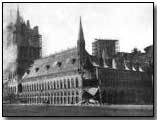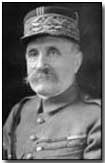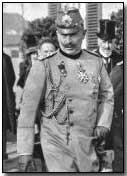First World War.com - Battles (original) (raw)
Battles - The First Battle of Ypres, 1914
 With the failure of the German offensive against France at the Battle of the Marne, and the allied counter-offensive, the so-called 'race to the sea' began, a movement towards the North Sea coast as each army attempted to out-flank the other by moving progressively north and west. As they went, each army constructed a series of trench lines, starting on 15 September, that came to characterise war on the Western Front until 1918.
With the failure of the German offensive against France at the Battle of the Marne, and the allied counter-offensive, the so-called 'race to the sea' began, a movement towards the North Sea coast as each army attempted to out-flank the other by moving progressively north and west. As they went, each army constructed a series of trench lines, starting on 15 September, that came to characterise war on the Western Front until 1918.
Meanwhile French Commander-in-ChiefJoseph Joffre undertook an intensive combined allied attack on 14 September against the German forces on the high ground just north of the Aisne river. With the German defences too strong, the attack was called off on 18 September. Stalemate had set in.
By October the Allies had reached the North Sea at Niuwpoort in Belgium. German forces forced the Belgian army out of Antwerp, ultimately ending up in Ypres. The British Expeditionary Force (BEF), under Sir John French, took over the line from Ypres south to La Bassee in France, from which point the French army continued the line down to the Swiss border.
Such was the background to the First Battle of Ypres, which commenced on 14 October when Eric von Falkenhayn, the German Chief of Staff, sent his Fourth and Sixth armies into Ypres.
 The battle began with a nine-day German offensive that was only halted with the arrival of French reinforcements and the deliberate flooding of the Belgian front. Belgian troops opened the sluice gates of the dykes holding back the sea from the low countries.
The battle began with a nine-day German offensive that was only halted with the arrival of French reinforcements and the deliberate flooding of the Belgian front. Belgian troops opened the sluice gates of the dykes holding back the sea from the low countries.
The flood encompassed the final ten miles of trenches in the far north, and which later proved a hindrance to the movement of allied troops and equipment.
During the attack British riflemen held their positions, suffering heavy casualties, as did French forces guarding the north of the town.
The second phase of the battle saw a counter-offensive launched by General Foch on 20 October, ultimately without success. It was ended on 28 October.
 Next, von Falkenhayn renewed his offensive on 29 October, attacking most heavily in the south and east - once again without decisive success. Duke Albrecht's German Fourth Army had taken the Messines Ridge and Wytschaete by 1 November.
Next, von Falkenhayn renewed his offensive on 29 October, attacking most heavily in the south and east - once again without decisive success. Duke Albrecht's German Fourth Army had taken the Messines Ridge and Wytschaete by 1 November.
It also took Gheluvelt and managed to break the British line along the Menin Road on 31 October. Defeat was imminent, and the German Kaiser, Wilhelm II, was shortly to arrive to personally witness the taking of the town. However the arrival of French reinforcements saved the town, the British counter-attacking and recapturing Gheluvelt.
The author John Buchan (of The 39 Steps fame) later wrote in his history of the war:
Between two and three o'clock on Saturday, the 31st, was the most critical hour in the whole battle. The 1st Division had fallen back from Gheluvelt to a line resting on the junction of the Frezenberg road with the Ypres-Menin highway. It had suffered terribly, and its general had be en sorely wounded. On its right the 7th Division had been bent back to the Klein Zillebeke ridge, while Bulfin's two brigades were just holding on, as was Moussy on their right. Allenby's cavalry were fighting an apparently hopeless battle on a long line, and it seemed as if the slightest forward pressure would crumble the Ypres defense. The enemy was beginning to pour through the Gheluvelt gap, and at the same time pressed hard on the whole arc of the salient.
There were no reserves except an odd battalion or two and some regiments of cavalry, all of which had already been sorely tried during the past days. French sent an urgent message to Foch for re-enforcements, and was refused. At the end of the battle he learned the reason. Foch had none to send, and his own losses had been greater than ours. Between 2 and 2.30 Haig was on the Menin road, grappling with the crisis. It seemed impossible to stop the gap, though on its northern side some South Wales Borderers were gallantly holding a sunken road and galling the flank of the German advance. He gave orders to retire to a line a little west of Hooge and stand there, though he well knew that no stand, however heroic, could save the town. He foresaw a retirement west of Ypres, and French, who had joined him, agreed.
And then suddenly out of the void came a strange story. A white-faced staff officer reported that something odd was happening north of the Menin road. The enemy advance had halted! Then came the word that the 1st Division was reforming. The anxious generals could scarcely believe their ears, for it sounded a sheer miracle. But presently came the proof, though it was not for months that the full tale was known. Brigadier-General Fitz-Clarence, commanding the 1st (Guards) Brigade in the 1st Division, had sent in his last reserves and failed to stop the gap. He then rode off to the headquarters of the division to explain how desperate was the position. But on the way, at the southwest corner of the Polygon Wood, he stumbled upon a battalion waiting in support.
It was the 2nd Worcesters, who were part of the right brigade of the 2nd Division. Fitz-Clarence saw in them his last chance. They belonged to another division, but it was no time to stand on ceremony, and the officer in command at once put them at his disposal. The Worcesters, under very heavy artillery fire, advanced in a series of rushes for about a thousand yards between the right of the South Wales Borderers and the northern edge of Gheluvelt. Like Cole's fusiliers at Albuera, they came suddenly and unexpectedly upon the foe. There they dug themselves in, broke up the German advance into bunches, enfiladed it heavily, and brought it to a standstill. This allowed the 7th Division to get back to its old line, and the 6th Cavalry Brigade to fill the gap between the 7th and the 1st Divisions. Before night fell the German advance west of Gheluvelt was stayed, and the British front was out of immediate danger.
The German offensive continued for the following ten days, the fate of Ypres still in the balance. A further injection of French reinforcements arrived on 4 November. Even so, evacuation of the town seemed likely on 9 November as the German forces pressed home their attack, taking St Eloi on 10 November and pouring everything into an attempt to re-capture Gheluvelt on 11-12 November, without success.
A final major German assault was launched on 15 November; still Ypres was held by the British and French. By this time the Belgian autumn had set in with the arrival of heavy rain followed by snow. Von Falkenhayn called off the attack.
It was becoming evident that the nature of trench warfare favoured the defender rather than the attacker. In short, the technology of defensive warfare was better advanced that that of offensive warfare, the latter proving hugely costly in terms of manpower.
The BEF had held Ypres, as they continued to do until the end of the war despite repeated German assault; the Allies also held a salient extending 6 miles into German lines.
The cost had been huge on both sides. British casualties were reported at 58,155, mostly pre-war professional soldiers, a loss the British could ill-afford. French casualties were set at around 50,000, and German losses at 130,000 men.
Click here to view a map of the German retreat following the Marne battle and the subsequent race to the sea.
Photographs courtesy of Photos of the Great War website
The Western Front Today: Menin Gate
The Western Front Today: Ypres Cloth Hall
The Western Front Today: Hellfire Corner
Joseph Joffre's Report on the First Battle of Ypres
"Harry Tate" was the nickname given by British pilots to the R.E.8 aircraft
- Did you know?